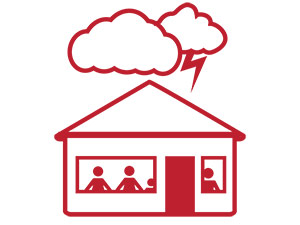Shelter In Place
 You can prepare for potential hazards by having a plan in place to deal with anticipated impacts of an event. Having your plan and emergency kit prepared in advance is the best way to support your family and pets. You may need to Shelter in Place or “hunker down” in your home for at least 72 hours (3 days) without needing to leave for supplies. Plan to be without power in many hazards that could occur.
You can prepare for potential hazards by having a plan in place to deal with anticipated impacts of an event. Having your plan and emergency kit prepared in advance is the best way to support your family and pets. You may need to Shelter in Place or “hunker down” in your home for at least 72 hours (3 days) without needing to leave for supplies. Plan to be without power in many hazards that could occur.
“Shelter in Place” refers to remaining inside the home or building where you are, while waiting for the end of the threat, and also taking certain precautions. This activity can be an alternative or a complement to evacuation and may be necessary during certain types of emergencies. During a dangerous goods/chemical spill, you may be asked to shelter in place, or for a blizzard, hurricane or flood.
Most emergency events in Lunenburg County are caused by weather. Heavy rainfall and hurricanes happen in summer and fall. Blizzards, ice storms, and snow/rain mixes happen in winter and spring. High winds, flooding, storm surges and icy conditions can make driving dangerous and cause power outages for 3 days or more. Climate changes are likely to create stronger storms more often in Lunenburg County.
Shelter in Place or “hunker down” means you are ready to comfortably stay in your home for at least 3 days without needing to go out for supplies even if the power is off. Although the 9-1-1 lines stay open, help may take longer to get to you during storm conditions. Everyone’s shelter in place plan should be unique to their family’s circumstances. For example, water for farm animals, special medications, batteries, oxygen, signing up with your electric provider to let them know you have electric life-sustaining equipment. Go to Special Needs for more information.
Many weather events also affect the electrical grid. What would you lose if there is an extended power outage?
What would your family need to thrive for 3 to 4 days if businesses were closed, roads impassable and the power was out?
To answer this question, consider what your household needs based on power outage and road closures. Check the things you would have and the things you should get before a storm hits.
Household Needs List
| Supplies | Have in House | Get When Event Predicted |
|---|
Food
(3-4 day meals based on utility outages; storage & cooking impacts) |
|
|
Water - drinking
(4L per person/day) |
|
|
Water - sanitation
|
|
|
| Water - cooking |
|
|
| Fuel - heating |
|
|
| Fuel - vehicle, plow, snow blower, boat |
|
|
| Fuel - cooking |
|
|
Information Sources
(radio, T.V. computers, smartphone) |
|
|
| Non-portable phone |
|
|
| Cell Phones |
|
|
| Batteries/charging devices |
|
|
| Flashlights |
|
|
| Toiletries |
|
|
Medications & devices
(prescriptions, OTC, syringes, oxygen) |
|
|
Entertainment
(books, movies, games) |
|
|
| Work Supplies |
|
|
| Cash |
|
|
| Disposable cups, plates, utensils |
|
|
Cleaning supplies
(soap, liquid detergent, wet wipes, garbage bags) |
|
|
Pet Supplies
(food, water, waste removal) |
|
|
What should I do?
In Storm warning phase
- Stock "Household Needs List"
- Make child/pet arrangements (school closure plans, pet care)
- Re-schedule travel plans
- Make "work from home" plans
- Test back-ups (flashlights, generators)
- Consider filling bathtubs/containers for water sources
- Charge battery-operated devices
- Talk about your plan with family members
- Check on your neighbour
- Supplies for your pets and farm animals
- Ensure you have a supply of special medications, batteries, oxygen, etc.
- Signing up with your electric provider if you have electrical, life-sustaining equipment
During and immediately after the storm
- Monitor radio and local media
- Keep devices charged and ready
- Stay off the roads
- Use "work from home" plans
- Use "Household Needs List"
- Keep pets safe
- Use alternative heat and cooking sources safely
In Lunenburg County, neighbours help neighbours. After the storm has passed Comfort Centres may open to supporting local residents. These stations provide a place to get warm, recharge devices, check on each other and share information. Resources available vary with the community and resident needs. These centres are operated by the community for the community.
pdf
REMO Shelter In Place Brochure(302 KB)


 You can prepare for potential hazards by having a plan in place to deal with anticipated impacts of an event. Having your plan and emergency kit prepared in advance is the best way to support your family and pets. You may need to Shelter in Place or “hunker down” in your home for at least 72 hours (3 days) without needing to leave for supplies. Plan to be without power in many hazards that could occur.
You can prepare for potential hazards by having a plan in place to deal with anticipated impacts of an event. Having your plan and emergency kit prepared in advance is the best way to support your family and pets. You may need to Shelter in Place or “hunker down” in your home for at least 72 hours (3 days) without needing to leave for supplies. Plan to be without power in many hazards that could occur.